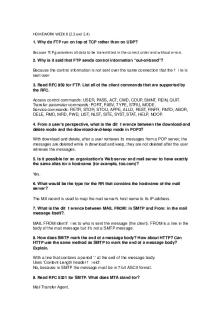Homework Week #3 PDF

| Title | Homework Week #3 |
|---|---|
| Author | JR Jonsson |
| Course | International Finance |
| Institution | California State University Monterey Bay |
| Pages | 2 |
| File Size | 97 KB |
| File Type | |
| Total Downloads | 75 |
| Total Views | 133 |
Summary
Weekly homework worth 5% each. ...
Description
XXXXXX FIN-630-003 Professor Nakshbendi (09/12/2020) Homework Week #3 Q(3-2): Financial ratio analysis is conducted by managers, equity investors, long-term creditors, and short-term creditors. What is the primary emphasis of each of these groups in evaluating ratios? T he emphasis of the various types of analysts is by no means uniform nor should it be. Management is interested in all types of ratios for two reasons. First, the ratios point out weaknesses that should be strengthened; second, management recognizes that the other parties are interested in all the ratios and that financial appearances must be kept up if the firm is to be regarded highly by creditors and equity investors. Equity investors are interested primarily in profitability, but they examine the other ratios to get information on the riskiness of equity commitments. Long-term creditors are more interested in the debt ratio, TIE, and fixed-charge coverage ratios, as well as the profitability ratios. Short-term creditors emphasize liquidity and look most carefully at the liquidity ratios.
Q(3-6): Why is it sometimes misleading to compare a company’s financial ratios with those of other firms that operate in the same industry? T he main reason why it can be misleading to compare a company’s financial ratios with its competitors is that firms within the same industry may employ different accounting techniques that make it difficult to compare financial ratios, more fundamentally, comparisons may be misleading if firms in the same industry differ in their other investments. for example, comparing PepsiCo and Coca-Cola may be misleading because apart from their soft drinks business, Pepsi also owns other businesses, such as Frito-lay and quaker. This is only
Problem(3-2): Vigo Vacations has $200 million in total assets, $5 million in notes payable, and $25 million in long-term debt. What is the debt ratio? DEBT-RATIO = Total debt/Total asset = (($5million+$25million)/$200 million) = 0.15 or 15% debt ratio.
Problem(3-6): Gardial & Son has a ROA of 12%, a 5% profit margin, and a return on equity equal to 20%. What is the company’s total assets turnover? What is the firm’s equity multiplier? a. Total assets turnover = Sales/Total assets = 0.12/0.05 = 2.4 b. Equity multiplier = ROE/ROA or Total assets/stakeholder’s equity. Equity multiplier = 0.20/0.12 = 1.67...
Similar Free PDFs

Week 3 Homework Questions
- 3 Pages

Week 3 Homework Solutions
- 13 Pages

Homework Week #3
- 2 Pages

Homework Week 3 Jones
- 6 Pages

Homework Week 3
- 4 Pages

ACCT3 Week 3 Homework
- 10 Pages

STAT 200 Week 3 Homework Problem
- 6 Pages

Week 4 Homework
- 12 Pages

Evolution Homework week 1
- 1 Pages

Week two, homework exercise
- 5 Pages

Homework week 8 - Solucion
- 2 Pages

Week 1 Homework Problems
- 3 Pages

Week 10 homework
- 3 Pages

Week 2 Homework Solutions
- 12 Pages

Week 1 Homework Assignment
- 1 Pages
Popular Institutions
- Tinajero National High School - Annex
- Politeknik Caltex Riau
- Yokohama City University
- SGT University
- University of Al-Qadisiyah
- Divine Word College of Vigan
- Techniek College Rotterdam
- Universidade de Santiago
- Universiti Teknologi MARA Cawangan Johor Kampus Pasir Gudang
- Poltekkes Kemenkes Yogyakarta
- Baguio City National High School
- Colegio san marcos
- preparatoria uno
- Centro de Bachillerato Tecnológico Industrial y de Servicios No. 107
- Dalian Maritime University
- Quang Trung Secondary School
- Colegio Tecnológico en Informática
- Corporación Regional de Educación Superior
- Grupo CEDVA
- Dar Al Uloom University
- Centro de Estudios Preuniversitarios de la Universidad Nacional de Ingeniería
- 上智大学
- Aakash International School, Nuna Majara
- San Felipe Neri Catholic School
- Kang Chiao International School - New Taipei City
- Misamis Occidental National High School
- Institución Educativa Escuela Normal Juan Ladrilleros
- Kolehiyo ng Pantukan
- Batanes State College
- Instituto Continental
- Sekolah Menengah Kejuruan Kesehatan Kaltara (Tarakan)
- Colegio de La Inmaculada Concepcion - Cebu
